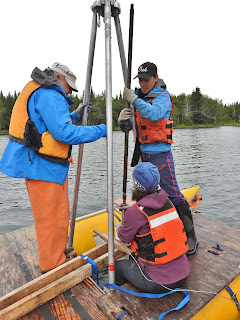“Welcome
to Alaska (soon)!” wrote Kat O’Brien in response to a post I made on the
listserv for the Ecological Society of America. In preparation for my
sabbatical in Alaska, I was reaching out to scientists who might be willing to
let me tag along on their research or visit their lab so I could gain a better
understanding of how science is done…and then write about it for Natural
Connections.
Kat
was one of the first and friendliest people to respond to my post. She
continued, “I work in a threespine stickleback facility and we often go out
collecting up in Talkeetna and Big Lake. If you have any interest in stuff like
that, let me know!” She closed her email with “Please bring cheese.”
Well,
I couldn’t manage to transport Wisconsin cheese safely for almost two months
without a cooler, and I missed out on their field work, but Kat still invited
me to come see their labs on the University of Alaska Anchorage campus. As I walked
out of the cold drizzle and into the Ecosystem-Biomedical Health building, not
just one, but four young women greeted me inside. Two were students (one
undergrad, one Master’s) doing research on threespine sticklebacks, and another
was the lab manager whose job it was to order supplies and keep everyone
organized so that the fish stayed alive. Kat O’Brien was the one with wild red
hair. She’s a Husbandry Technician for UAA.
Introductions
were short, because the scientists were excited to show me their fish. We entered
a small white room lined with three levels of tanks. The top two shelves held research
subjects, and on the bottom level were effluent tanks which filter dirty water
cycled out of the tanks. As inch-long threespine sticklebacks (Gasterosteus aculeatus) hovered in their
tanks, Kelly Ireland (the Master’s student) enthusiastically listed the
benefits of sticklebacks as study subjects. Many folks (including me) would
just call them a minnow, but they are so much more.
These
small native fish are easy to collect, and relatively easy to keep alive and
breed in the lab, making them good research subjects. Sticklebacks feed a lot
of sport fish, and they are regarded as a “sentinel species” who could alert of
us of environmental issues before they pose a significant threat to humans.
Sticklebacks
are widespread, and are native throughout the Northern Hemisphere. My groups of
5th graders used to catch threespine sticklebacks in tidepools on
the coast of Northern California. They’ve also been introduced into the Great
Lakes. Those are two quite different habitats, and while the sticklebacks who
inhabit them are the same species, they look quite different. In all of those
habitats, sticklebacks have their three namesake-spines in front of the dorsal
fin. But their phenotype—physical
characteristics that vary based on the way their genes interact with their
environment—changes from freshwater to brackish water.
What
also caught my attention was that threespine sticklebacks live in Japan. They
are almost circumpolar, just like some of my favorite plants! (Their absence
from the north coast of Siberia, the north coast of Alaska, and the Arctic
islands of Canada prevents them from being truly circumpolar.) Just a few weeks
ago, hundreds of researchers gathered in Kyoto, Japan, for the 9th
International Conference on Stickleback Behavior and Evolution.
I
wasn’t sure what to expect when Kat invited me to their lab, but five minutes
into my visit, I was hooked on the young women’s enthusiasm and this cute little
research subject with big eyes and transparent juveniles.
 |
| Young threespine sticklebacks are transparent, which makes it easy to study the contents of their guts. Photo by Emily Stone. |
With
all the homemade tank systems, plumbing, electronics and tools packed into
their lab, (as well as their sense of fun and friendship on the research team)
these young women reminded me a lot of the sediment coring crew I went out
with. This type of science can’t be done without getting wet, dirty, using
tools, and doing a lot of problem solving.
What
useful science could they possibly do, though, with these tiny critters? In
that first room full of tanks, the left wall had all been treated with different
concentrations of Fluridone. This herbicide is used on entire lakes or rivers
to treat aquatic invasive plants. In Alaska, Elodea is the target. In Wisconsin, it’s used on Eurasian watermilfoil.
So far, the herbicide seems safe to use. The lab and its collaborators are looking
at how it impacts the sticklebacks’ microbiome—or all the bacteria that live in
and on their bodies.
This
lab is also using experiments to study how changes in the fish’s microbiomes
impact their growth, development, and immune systems, as well as the impact of
crude oil on their health. The right wall is a “common garden experiment,”
explained Kelly. “We’re seeing how different stickleback populations respond
when raised with the same microbiomes, to see how genetic background and
microbes interact.”
It
was a whirlwind visit, and as Kat walked me out of the lab, we talked about how
great it is to work in a team of women. “This is the first lab I’ve worked in
where the PI (principal investigator) is a woman. Dr. Kat Milligan-Myhre really
listens to us and makes us all feel like true collaborators.” It’s good to know
that—at least in some cases—that is how science is done.
For more information on sticklebacks, read an
article by researcher Kelly Ireland here: http://northexposure.net/2017/12/05/stickleback-the-super-fish/. Emily is in Alaska
for the summer! Follow the journey in this column, and see additional stories
and photos on her blog: http://cablemuseum.org/connect/.
For 50 years, the Cable Natural History
Museum has served to connect you to the Northwoods. Come visit us in Cable, WI!
Our new exhibit: “Bee Amazed!” is open.


































































